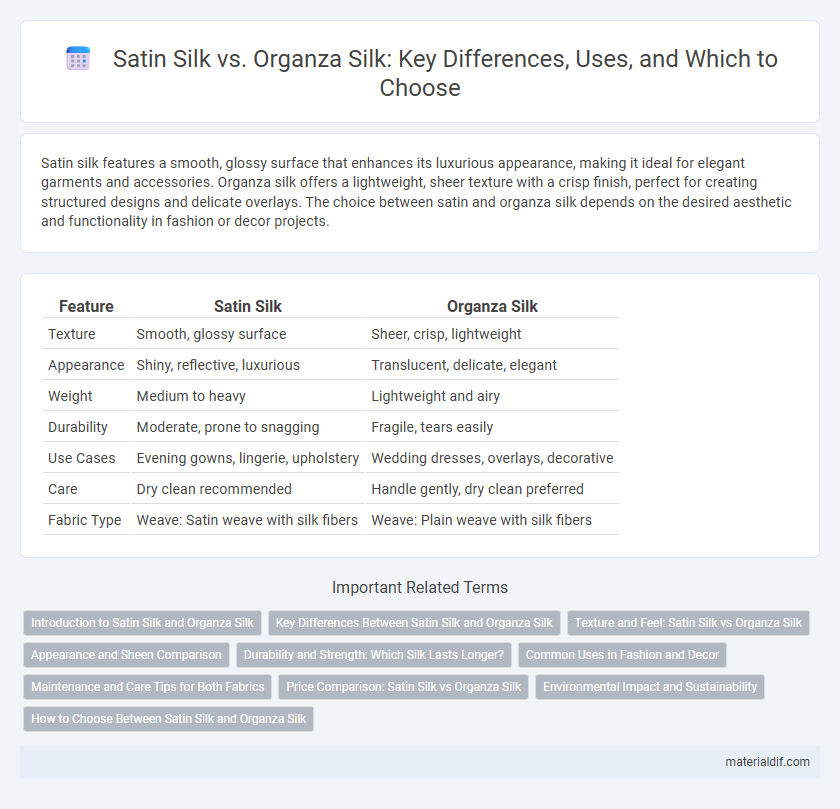Satin silk features a smooth, glossy surface that enhances its luxurious appearance, making it ideal for elegant garments and accessories. Organza silk offers a lightweight, sheer texture with a crisp finish, perfect for creating structured designs and delicate overlays. The choice between satin and organza silk depends on the desired aesthetic and functionality in fashion or decor projects.
Table of Comparison
| Feature | Satin Silk | Organza Silk |
|---|---|---|
| Texture | Smooth, glossy surface | Sheer, crisp, lightweight |
| Appearance | Shiny, reflective, luxurious | Translucent, delicate, elegant |
| Weight | Medium to heavy | Lightweight and airy |
| Durability | Moderate, prone to snagging | Fragile, tears easily |
| Use Cases | Evening gowns, lingerie, upholstery | Wedding dresses, overlays, decorative |
| Care | Dry clean recommended | Handle gently, dry clean preferred |
| Fabric Type | Weave: Satin weave with silk fibers | Weave: Plain weave with silk fibers |
Introduction to Satin Silk and Organza Silk
Satin silk is a smooth, glossy fabric characterized by its tightly woven, lustrous surface, commonly used in eveningwear and luxury bedding due to its soft drape and rich texture. Organza silk is a lightweight, sheer fabric with a crisp hand, often employed in bridal gowns and overlays for its translucent quality and structured form. Both fabrics originate from silk fibers but differ significantly in weight, texture, and typical applications, catering to distinct design preferences in fashion and decor.
Key Differences Between Satin Silk and Organza Silk
Satin silk features a smooth, glossy surface created through a weaving technique that highlights its luxurious sheen and fluid drape, making it ideal for evening wear and elegant gowns. Organza silk is a lightweight, sheer fabric with a crisp texture and structured form, often used in bridal attire and decorative overlays due to its ability to hold shape. The primary differences lie in satin's softness and shine versus organza's transparency and stiffness, influencing their respective applications in fashion design.
Texture and Feel: Satin Silk vs Organza Silk
Satin silk features a smooth, glossy surface with a luxurious, slippery feel that drapes elegantly, making it ideal for evening wear and lingerie. Organza silk offers a crisp, stiff texture with a sheer, lightweight quality that holds its shape well, often used in bridal gowns and overlays. The tactile difference lies in satin's fluid softness versus organza's structured firmness, catering to distinct design aesthetics.
Appearance and Sheen Comparison
Satin silk features a smooth, glossy surface with a high sheen that reflects light beautifully, creating a luxurious and elegant appearance. Organza silk, in contrast, is lightweight and sheer with a crisp texture and a subtle, delicate shimmer rather than a pronounced shine. The distinct differences in appearance and sheen make satin silk ideal for flowing garments, while organza silk is preferred for structured designs and layering effects.
Durability and Strength: Which Silk Lasts Longer?
Satin silk, characterized by its tightly woven structure, offers greater durability and strength compared to the more delicate, sheer nature of organza silk, which is prone to snagging and tearing. The dense weave of satin silk enhances its resistance to wear and extensibility, making it ideal for garments requiring longevity. Organza silk, while elegant and lightweight, generally requires careful handling due to its lower tensile strength and susceptibility to damage over time.
Common Uses in Fashion and Decor
Satin silk, prized for its smooth, glossy surface, is commonly used in evening gowns, lingerie, and luxurious bedding due to its elegant drape and rich texture. Organza silk, known for its sheer, crisp quality, is often chosen for bridal veils, formal overlays, and decorative home accents to add structure and lightness. Both fabrics enhance high-end fashion and interior decor, with satin silk offering opulence and organza silk providing delicate volume.
Maintenance and Care Tips for Both Fabrics
Satin silk requires gentle hand washing with mild detergent and air drying to maintain its smooth, glossy texture, while avoiding direct sunlight to prevent color fading. Organza silk demands careful handling with cold water rinses and minimal agitation to preserve its crisp, sheer structure, often benefiting from professional dry cleaning for stubborn stains. Both fabrics should be stored in breathable garment bags away from moisture and heat to extend their lifespan and retain their luxurious appearance.
Price Comparison: Satin Silk vs Organza Silk
Satin silk generally commands a higher price than organza silk due to its denser weave and luxurious sheen, which require more intricate manufacturing processes. Organza silk, known for its lightweight and sheer texture, tends to be more affordable, making it popular for delicate overlays and bridal wear. Market prices for satin silk typically range from $30 to $100 per yard, while organza silk is priced between $20 and $60 per yard, reflecting differences in material weight and production complexity.
Environmental Impact and Sustainability
Satin silk production typically involves higher water and chemical usage due to its dense weave and finishing processes, leading to a greater environmental footprint compared to organza silk. Organza silk, characterized by its lightweight and sheer texture, often requires less energy and fewer resources, promoting better sustainability credentials. Sustainable silk sourcing and eco-friendly dyeing methods can further reduce the environmental impact of both satin and organza silk fabrics.
How to Choose Between Satin Silk and Organza Silk
Choosing between satin silk and organza silk depends on the desired texture, appearance, and functionality of the fabric. Satin silk offers a smooth, glossy finish ideal for elegant evening wear and lingerie, while organza silk provides a lightweight, sheer, and crisp texture perfect for overlays and bridal gowns. Consider the garment's purpose and comfort needs to select the fabric that best balances luxury with practicality.
Satin silk vs Organza silk Infographic

 materialdif.com
materialdif.com